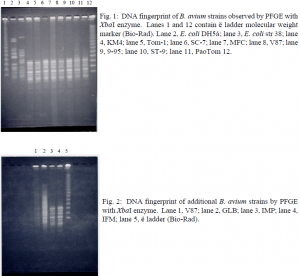Kristilyn Rogers and Dr. Ron W. Leavitt, Microbiology
Bordetellosis, or turkey coryza, is a highly contagious respiratory disease in poultry caused by Bordetella avium. Turkey growers worldwide are concerned with this disease which results in millions of dollars in losses annually to the turkey industry. Bordetellosis is readily transmitted through close contact with those already infected, or by exposure to contaminated litter or water. Infected turkeys experience, among other things, stunted growth and a predisposition for other infectious diseases. The mortality rate for bordetellosis is less than 10%. However, morbidity rates can reach 80-100% in young poults. Moreover, with concurrent infection of B. avium and Escherichia coli, mortality rates can increase to 40% or more (1).
Ten different outbreaks of bordetellosis occurred at the Moroni Turkey Farms in Moroni, Utah in the past 13 years. Samples of the bacterial causative agent were collected and isolated from these outbreaks. The research in this project focused on whether the pathogenic strains were identical or unrelated, and also how these strains compared to the vaccine strain.
DNA fingerprints were created by pulsed-field gel electrophoresis (PFGE) to determine whether the strains were related (2). The B. avium strains were cultured in brain-heart infusion (BHI) media. An appropriate concentration of cells was transferred to melted agarose and allowed to solidify into plugs. The plugs were incubated overnight in proteinase K which lysed the cells inside the plugs, releasing the chromosomal DNA into the agarose. The DNA was digested with XbaI, a restriction endonuclease that recognizes and cleaves the DNA at a specific eight base-pair sequence. The resulting fragments were separated according to molecular weight by pulsed-field gel electrophoresis. The separation created a series of bands that were visualized under UV light after staining with ethidium bromide. The resulting fingerprints from the 10 pathogenic strains of B. avium were compared against the V87 strain which was altered to be used as a vaccine.
From the outset, it was expected that each pathogenic strain would produce a unique fingerprint. Instead, all but the GLB strain of B. avium, isolated from the most recent outbreak, appeared nearly identical (see figures).
There are several possible explanations for the similarity in the fingerprints among the different strains. One possibility is that the differences between the strains are not significant enough to be detected by PFGE. Another possibility is that previous outbreaks were actually caused by the vaccine strain V87. The vaccine was originally created from a once virulent strain of B. avium that had mutated. It is possible that the V87 strain reverted to its original form, causing the outbreaks. Based on the difference in the fingerprint of the GLB strain, such a scenario would suggest that the most recent outbreak was caused by contamination from some other source.
The question of relatedness between these bacterial strains continues to be investigated. During summer 1999, work was underway to create DNA fingerprints by random amplification of polymorphic DNA (RAPD) using the polymerase chain reaction (PCR). This method for creating DNA fingerprints is more sensitive to small differences among related bacterial strains.
References
- Arp, L.H. and J.K. Skeeles. Bordetellosis (Turkey Coryza). In: Diseases of Poultry, 9th ed. B. W. Calnek, H. J. Barnes, C. W. Beard, W. M. Reid, and H. W. Yoder, eds. Iowa State University Press. Ames, Iowa. pp. 277-288. 1991.
- Barrett, T. J., H. Lior, J. H. Green, R. Khakhria, J. G. Wells, B. P. Bell, K. D. Greene, J. Lewis, and P. M. Griffin. Laboratory investigation of a multistate food-borne outbreak of Escherichia coli 0517:H7 by using Pulsed-field gel electrophoresis and phage typing. J. Clin. Microbiol. Dec:3013-3017. 1994.

